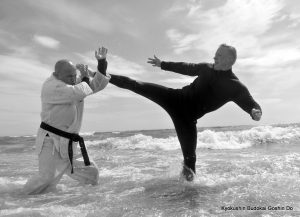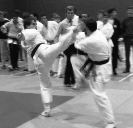HANSHI MARC HOWES
FOUNDER JIGOKU DOJO est. 1988
GALLERY

The history of the Jigoku Dojo stretches back to the early 1980s. Hanshi Howes has always had a pragmatic viewpoint on karate training and believes that hard, simple training, linked with repetition is the key to producing strong and capable karateka. During this time period we trained in a dojo that had bare wooden floorboards which, before training had a white bleached look, but quickly became black with the accumlated sweat. No windows were allowed to be opened and the heat was, on occasion, truly terrible. One senior student had to attend a wedding and missed training, but with a little time to spare had decided to pop in for a quick look. As he opened the door a wave of heat hit him which genuinely made him stagger back, at which point he gasped, "Bloody hell! It's as hot as Hades in here!"
Soon, extra hard sessions became known as 'Hell Sessions', then Hanshi Howes found that the Japanese translation for this was 'Jigoku' and then they were called 'Jigoku Sessions', the obvious soon occurred and in 1988 the club began to be called Jigoku Dojo. It must be pointed out at this point that there is absolutely NO religious attachments here. Our symbol is based on the Japanese Oni, which is from Japanese folklore. In ancient Japanese folklore the Oni were the mischief makers, similar to Loki in Norse folklore. However, as is often the case, in more recent times, Oni have lost some of their original naughtiness and now often take on a more protective function. For example, men in Oni costumes often lead Japanese parades to ward off any bad luck. Also, Japanese buildings sometimes include Oni-faced roof tiles called onigawara, which are thought to ward away bad luck, much as gargoyles in Western tradition.

This Oni is seen carrying iron clubs, which are called kanabo. This image leads to the expression "oni with an iron club" (oni-ni-kanabo), that is, to be invincible or undefeatable. It can also be used in the sense of "strong beyond strong." It seemed like a perfect fit for the philosphy of the Jigoku Dojo.








